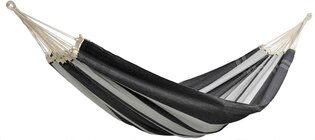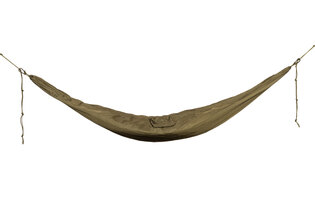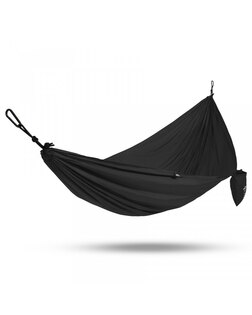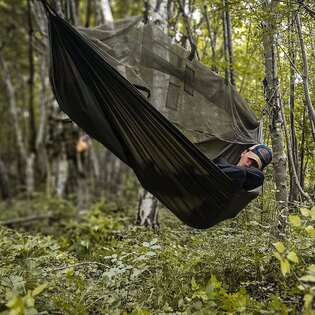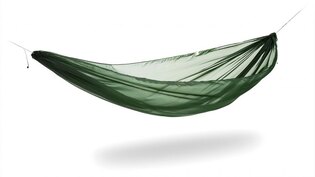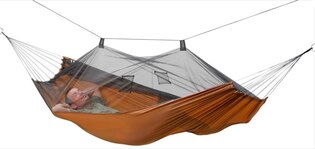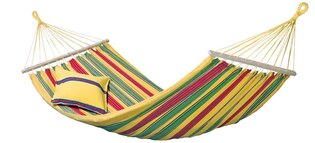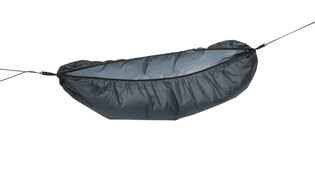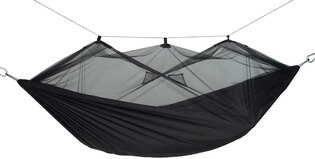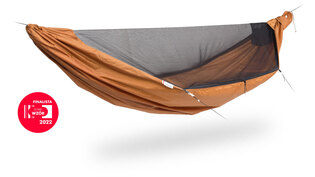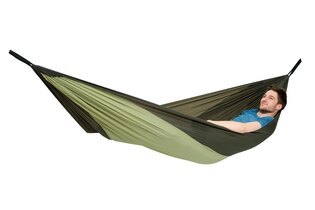Choosing a hammock for comfortable sleeping in nature
Sleeping in a hammock can be a great outdoor experience. However, in order for this to be the case, you need to choose a quality model and also figure out how to fix it properly and how to sleep comfortably in it. In today's article, we will focus on choosing a hammock, as well as how to hang it, stretch it, and also on accessories that can make sleeping in a hammock easier for you. Finally, we will add some advice and tips for an even more comfortable experience of sleeping in a hammock.
Sleeping in a hammock has been on the rise lately. Compared to sleeping on a mat on the ground, it has one indisputable advantage: you don't have to deal with the terrain below you (and for more sensitive people, the fact that something will crawl on them in the evening). Compared to a mat, however, there are more variables on which a comfortable sleep depends.
With a mat, you need a flat surface without obstacles, such as stones, branches, roots, etc. You also definitely cannot avoid checking the surface for sharp objects that could damage the mat (especially an inflatable one). You don't have to deal with this with a hammock. Here you only need two trees at a sufficient distance from each other and it doesn't matter if you are on a hill or on a plain full of various "obstacles".
However, what you need to be careful about is choosing the right hammock and then also hanging it up. This is where problems most often arise that can discourage novice users from using hammocks. At the same time, I would also avoid placing the hammock in places where there is a risk of direct wind (not that the hammock can't withstand it, but in stronger winds you can turn from a calm hammocker into a Captain Corcoran not in control of sailing in rough seas). Below we will tell you how to avoid beginners' mistakes and what to watch out for.

One of the representatives of "multifunctional" hammocks is the Mosquito Traveler Thermo XXL from Amazonas.
How to choose a hammock
On the market, you will find a large number of products that differ in mat, construction, load capacity, length, etc. Let's not confuse a hammock with a garden net. These are two diametrically different products, where one serves as a full-fledged system for sleeping in nature, the other for momentary relaxation.
So what are the main considerations for choosing a hammock?
1. Hammock length
Choose the length of the hammock not only according to your height, but also according to the principle of sleeping over. The minimum length of the hammock is your height + min. 100 cm extra (reserve 50 cm under the feet and 50 cm above the head). Longer means better for positioning your body during sleep.
2. Hammock width
The correct way to sleep in a hammock is when you don't lie in the hammock lengthwise with the axis of the hammock (aka "the banana" position), but across (that is, you "open" the hammock with your body to the width, thereby avoiding the mentioned banana position and you sleep beautifully on the plane. In a hammock, you usually sleep at an angle of 15-30 degrees from the axis of the hammock. Simply put, you sleep "diagonally".
3. mat and associated load capacity
Choose the mat of the hammock ideally with a ripstop treatment (that is, one that is woven in a special way, so that when the hammock is disrupted, it does not completely tear).
The usual load capacity on the market for hammocks is approx. 120 kg, but don't forget that when you "install" your person, the hammock is subjected to dynamic loads (sitting, swinging, positioning in the hammock) and if you are heavier like me, this load capacity may not be enough for you. Therefore, it is better to choose a higher load capacity (the mat are more durable and the quality of such hammocks is generally higher).

The Draka hammock from Lesovik, as one of the manufacturers of high-quality hammocks with a high load capacity of up to 250 kg.
4. Tree fastening system
Depending on the length of the hammock, we are talking about a suitable space between the trees, about 4-6 meters long. Such a space will ensure proper fastening and proper stretching of the hammock, i.e. its suspension.
The standard suspension system is a point one, i.e. the ends of the hammock are stitched at the extreme points with an eyelet that you attach to straps, for example with a carabiner.
On the market, however, you will also come across clamps, when the hammock is not shaped like a "crescent" but a rectangle after being stretched. Such hammocks are intended for sleeping horizontally, i.e. in the axis of the hammock. Again, it's up to you what you prefer. Rectangular hammocks usually need to be fixed to the ground with side straps/ropes for stability (as is the case with tents), which makes the principle of fastening the hammock more complicated and requires more practice.
TIP: I switched from regular rope ties to the universal Amazonas T-Strap ties, which are strength belt ties (there is no slipping on the tree trunk under load). In addition, this principle is much more gentle for the tree, specifically for its bark. Installation is also possible with one hand, and slackening or stretching the hammock is simple using the cleverly designed "brake".
5. Multi-purpose or simple construction?
What is meant by this? Nowadays, many manufacturers already offer hammocks with a completely integrated mosquito net, which you then close with a zipper. Here it is especially important to hang the hammock correctly, as incorrect hanging could cause damage to the mosquito net when the hammock is loaded (it is stretched by a separate lanyard attached to the trees, and its excessive tension can cause the mesh mat to tear after the hammock is loaded).
And why is such a hammock called multi-purpose? In winter, in most cases you don't need a mosquito net, so you simply turn the hammock inside out and the net is on the underside. Some hammocks also have a pocket for a mat, which helps to fix it and prevents it from shifting during sleep. The simple construction is therefore logically without a mosquito net and often also without a pocket for a mat.
Clamping the hammock and its tension
An ideally suspended hammock has ties at an angle of about 30 degrees to the axis of the tree. This is recommended when sleeping "diagonally" mentioned above. Verification is done by a simple finger method, where the index finger is in a horizontal direction and the thumb is vertically upwards. You put the hand prepared in this way to the binding so that a triangle forms between the bindings and the ends of the fingers, where the binding is its base. If the index finger is pointing down, your hammock is loose, if, on the other hand, the index finger is pointing up, it is too tight.
You can also sleep in the "banana" position in a hammock, if you use an insulating cover – the so-called Cocoon, but we will talk about the insulation of the hammock in a separate paragraph below.
The ties should be fastened to the tree at a height of approx. 160-180 cm for the correct hanging of the hammock. If you hang it lower, you may be too close to the ground, you would have to tighten the hammock more and then change your sleeping position.
The ends of the hammock should be at the same height, otherwise you will slide towards one end or the other in the hammock.

You can fasten the Cocoon along its entire length, or leave only a smaller opening. Even full closing does not prevent the supply of fresh air through the openings at both ends of the cocoon.
Hammock insulation against adverse conditions
Just as the mat replaces the insulation of the lower part of the sleeping bag when it is laid down (plus it also acts as a cushioning layer between the solid base and the "sleeper"), it is necessary to insulate the lower part of the hammock in adverse conditions.
This is solved either with a mat inserted into the hammock or with an underquilt. You can learn more about underquilts in our earlier article on this issue. In short, an underquilt is an insulating blanket under a hammock. There are many variants, from light summer blankets to heavier winter blankets.
However, a special product is the Cocoon, which functions as a "sleeping bag on a hammock", i.e. you "lock" yourself in it along the entire length, including the hammock. This system is used primarily for the winter season, when temperatures reach below freezing, thereby minimizing heat loss. The cold simply won't reach you even from above.
Neither the underquilt nor the cocoon should be fully stretched, but should have an air insulation layer about the height of the palm of the hand. Then their functionality is correct and you may sleep better than in bed at home.
TIP: One thing you have to watch out for with hammock mat in cold and wet weather is the condensation of water vapor on the mat.
7 tips to conclude
1. Before "sharp" use, first practice hanging and tensioning the hammock somewhere in the garden or near your home. Even a moment of rest in a hammock on a one-day trip will show you where there are possible shortcomings when tying the hammock or tensioning it, and at the same time you will get used to sleeping "in the air".
2. Don't be afraid to spend more time choosing a place for the hammock and hanging it correctly. There is no rush, and a few extra minutes is a marginal mat in the context of a peaceful and comfortable sleep of several hours.
3. I definitely recommend taking a tarp with you as protection against adverse weather conditions.
4. Avoid places near feeders. From experience, a quiet night does not await you in such places.
5. Beware of resin, that well-known product of trees. As we know, resin sticks like hell and getting it out of hands, bindings, hammocks, etc. is a struggle.
6. You can't really sleep in two people in a hammock for two. That is, certainly not all night. A short rest maybe, but even so it is better if everyone has their own hammock.
7. As a bonus, it pays to have a multi-functional rope with you, such as paracord. You can use it as a replacement for damaged ties or perhaps a clothesline. When it's wet, you can use it to hang your backpack.
Readers are further interested






































































































































